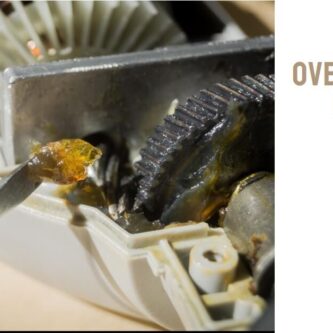Fans are common household appliances used to circulate air, cool rooms, and provide ventilation.
They come in different sizes and types, but most are powered by an electric motor. One question that often arises is whether you can run a 220v fan motor on 110 volts.
Running a 220v fan motor on 110 volts without a transformer can cause damage to the motor or other electrical components, as the motor is designed to operate at a specific voltage and frequency. However, with the use of a transformer, it is possible to safely convert the voltage and run the motor on 110 volts.
In this article, we will explore the answer to this question and discuss the potential risks and benefits of doing so.
Understanding Voltage
Before we can answer whether a 220 fan motor can run on 110 volts, it’s important to understand the concept of voltage.
Voltage is the electrical potential difference between two points in an electrical circuit, measured in volts.
In the United States, the standard household voltage is 110 to 120 volts, while larger appliances and equipment may require 220 to 240 volts.
The voltage requirements of a fan motor are determined by its electrical components, including the windings, rotor, and stator.
Can a 220 Fan Motor Run on 110?
The short answer is no, a 220v fan motor cannot run on 110 volts without a transformer.
The reason for this is that the motor is designed to operate at a specific voltage and frequency, and running it on a lower voltage can cause damage to the motor or other electrical components.
However, with the use of a transformer, it is possible to convert the voltage to 220 volts and safely run the motor.
Every electric motor is designed to operate at a specific voltage and frequency. If the motor is operated at a voltage lower than its rated voltage, the current flowing through its windings increases to maintain the same level of power, which can cause overheating and damage to the motor or other electrical components.
This can also result in reduced efficiency and increased power consumption. Therefore, it’s essential to operate a motor at the voltage and frequency specified by the manufacturer to ensure optimal performance and prevent damage.
Read also my article: Is Low Voltage Killing Your Ceiling Fan? Learn How to Protect It!
Alternatives to Running a 220v Fan Motor on 110
If you do not have access to a transformer or prefer not to use one, there are alternatives to running a 220v fan motor on 110 volts.
One option is to purchase a new fan motor that is designed to operate at 110 volts. Another option is to use a voltage converter or a step-up transformer to convert the voltage from 110 to 220 volts.
However, these options may not be practical or cost-effective for all situations.
How to Run a 220v Fan Motor on 110v
If you have determined that running a 220v fan motor on 110 volts with a transformer is the best option for your situation, there are several steps you can follow to ensure proper installation and function.
First, choose a transformer that is rated for the same voltage, power, and frequency as your motor.
Next, install the transformer according to the manufacturer’s instructions, taking care to connect the wiring correctly.
Finally, test the motor to ensure that it is operating safely and efficiently. Hire an electrician if you are not sure you can do it yourself.
Potential Risks of Running a 220v Fan Motor on 110
There are both risks and benefits to running a 220v fan motor on 110 volts with a transformer.
The main risk is that the motor may not operate efficiently or could be damaged due to the lower voltage.
Additionally, using a transformer can add to the cost and complexity of the setup.
Ultimately, the decision to run a 220v fan motor on 110 volts should be based on an evaluation of the specific situation and the potential risks and benefits.
Will it save energy consumption when running a 220v Fan Motor on a 110v
The power consumption of the motor remains the same regardless of the voltage it is operated at.
This is because power is equal to the product of voltage and current. So, if the voltage is decreased, the current will increase to maintain the same level of power.
However, running a motor on a lower voltage can result in decreased efficiency due to increased current draw, which can lead to overheating and damage to the motor, as well as increased power consumption.
Additionally, as I mentioned earlier, a lower voltage can cause a drop in the motor’s torque, affecting its performance and efficiency.
Therefore, while operating a motor on a lower voltage may appear to save energy in the short term, it can actually result in increased costs due to decreased efficiency, potential damage to the motor, and increased power consumption.
Conclusion:
In conclusion, running a 220 fan motor on 110 volts without a transformer is not recommended due to the potential for damage to the motor or other electrical components.
However, with the use of a transformer, it is possible to safely run the motor at 110 volts. As with any electrical setup, it’s important to carefully evaluate the situation and choose the best option for your needs.
you work With Electricity! Don’t leave empty-handed!
Looking to stay ahead of the game in the world of electrical engineering? Subscribe to my YouTube channel and gain access to exclusive content you won’t find anywhere else!
The staff I recommend (Amazon Affiliate Links to products I believe are high quality):
- Economy 120 Volt/60Hz AC Power Source – Step-Down Voltage & Frequency Converters 1800W
- UNI-T Digital Multimeter Tester UT139C
- 50-Amp Extension Cord for RV “100ft”
- Voltage Stabilizer 110/220v
- Hair Dryer “best selling“
- TOSHIBA EM131A5C-BS Countertop Microwave Ovens
Disclaimer: This contains affiliate links to Amazon products. I may earn a commission for purchases made through these links.



